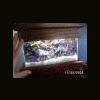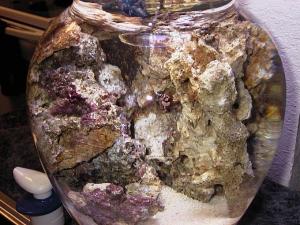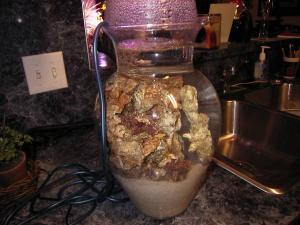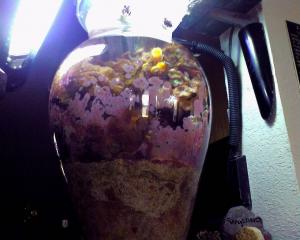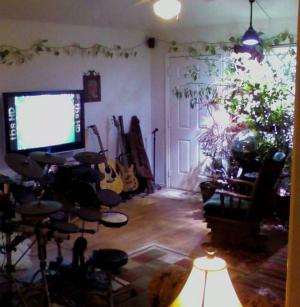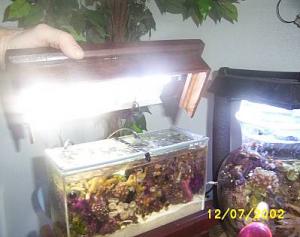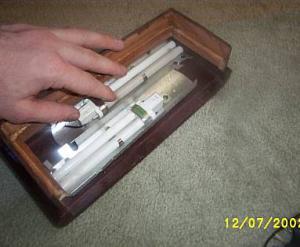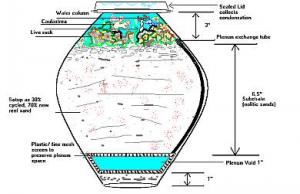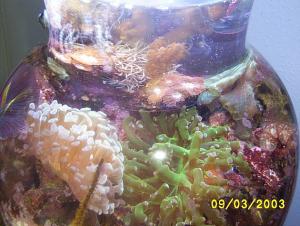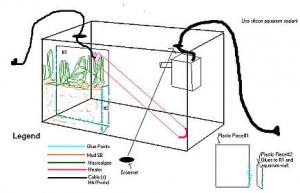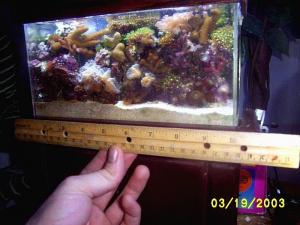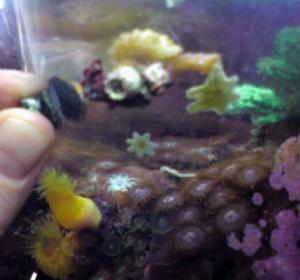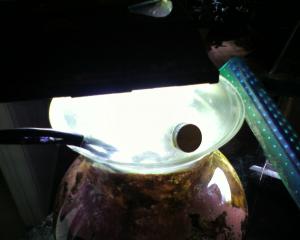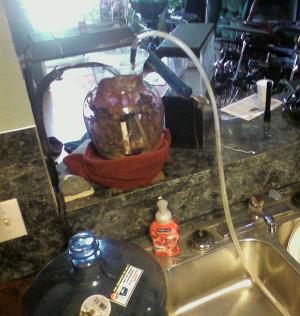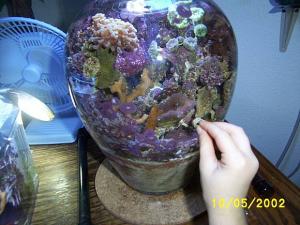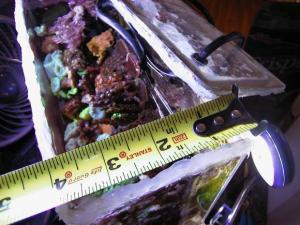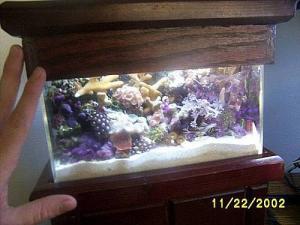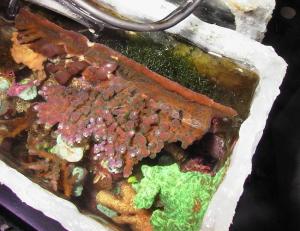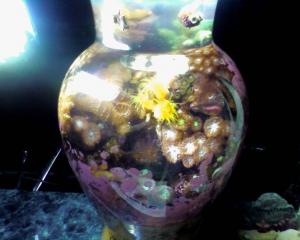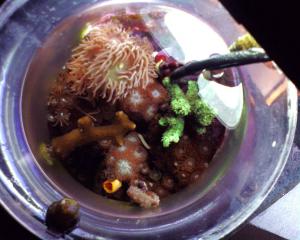-
Posts
63 -
Joined
-
Last visited
-
Days Won
1
Content Type
Profiles
Forums
Gallery
Everything posted by brandonm
-
great point about the sandbed, Im four years into it w no problems. Just wanted to add though that if you can see some of the color detail in the bed there are a lot of reds and shades of light green, no blacks indicating fouled pockets. since sunlight from a window hits the tank fully at 5 pm for 30 mins, this appears as a multi-hued color pattern of healthy algaes in the bed, rather than pockets of food or animal waste unprocessed. I really feel if the bowl held any untoward nutrients, and is unskimmed as it is, algae would wreck the system so be very careful how you feed a sandbedded tank in my opinion. although Id like it to be white to offset the top colors better, it looks about par for an ugly aged sandbed lol
-
just found this pic too. it shows the original rock structure in the bowl on day 1 of the build. If you compare this with the full grown shot earlier, you can see the rock facing has not been moved or repositioned at all in 4 years of submersion. I shudder to think what it might look like in between a rock bottom and the surface layer, but it still seems that if it were packing in detritus algae growth would be the first sign. I truly feel this feed-and-strip method is the near solution to detritus altogether> along with great removal of what does forum naturally the sexy shrimp was traded out for the stenopus coral banded. the thor a. was just too hard on my lps corals although I'd buy another one if they showed up again in lfs taking inverts out with a water change is easy, just siphon them right out into a net or you can blast clean them right out into the sink and catch them...
-
thanks guys for joining that's why I spend time promoting them like I do, methinks it should catch on faster as the vases are easily repeatable to prove it's sound science. they remedy so many problems I read about on the forums, topoff, water changes and algae prevention all solved and there's so much left to do in them when these lids allow you to leave the gallon tank alone for a few days by setting it low s.g before leaving on a ski vacation Ray I read a lot about the pros and cons from marine life air exposure. I can only speak for what I see in observing the bowl for several years, it does not hurt anything. The bacteria housed in an among the crevices in the tank are tough in that manner, the benthic life in the rock is withdrawn and a considerable amount of "padding" water is in the tubes and various interstices, still wet, so it's not to appear like they are dried out or anything. But you know interestingly man I don't rush to refill the tank at change time. sometimes Ill scrape microalgae off the glass for a few minutes when drained, Ive seen the adaptability of the corals to become much more fascinating than the vase reef itself. It may very well crash one day, hopefully a continually refined and dynamic approach to vase keeping will stave that off as long as possible lol the day it crashes Im hosting a giant online funeral, bet 50,000 will digitally attend ha ha
-
this tank looks great!! The blue casting is perfect for my taste and that ducted fan setup is pretty neat, looks like a turbo charger for your corals! well done, oustanding design and coral color/vitality B
-
also, even though I have not tested the water in years for anything, I feel it's highly possible the sandbed, and internal sufaces of the live rock are well aged enough to conduct nitrate reduction into nitrogen gas, the anaerobic nitrate reduction system. They claim it can't happen in pico reefs, but this sand bed is 4 inches deep and looks just like the aged sandbed of a 4 year old 100 gallon tank that does accomplish NNR, so what do 'they' know until they try one lol right?!? to me, this is very special science and a lot of it is new (such as the allelopathic studies) although the 'pros' still sometimes make comments about my tanks that they must be plumbed to a larger system, or grown out in a real tank and then transferred into these vessels. That kind of denial is the sincerest complement they could possibly give
-
Yes there is live sand, I will include a shot below. This tank breaks many rules as we all know deep sand beds store nutrients, but I am taking steps to remedy this problem. I feed only frozen mysis and other clean natural foods now. for the first two years I fed manmade pellets and saw the sand bed sink up a bit. since clean feeding for two years, and the sandbed fauna you can see in this pic, have cleaned out the areas and restored clarity. This vase is still an experiment, maybe it will crash, maybe it will go another four years only time will tell! Allelopathy is controlled more by the corals in my opinion than just water changes, but those help it to get started. it's my opinion that the overly-packed nature of the pico and the shared water space actually suppresses, not causes allelopathy due to overstimulation/stimulus neutralization etc. something has to explain the coral health, and the degree of actual physical touching in the bowl you can see if you use the pause button in the video. I really like talking with you all thank you for joining my thread! I actually did gag when taking the bobbit worm out, in half, with a bristleworm trap. his five jaws almost made me lose lunch (puke emoticon lol) cdckjn although weekly water changes are the commitment, i feel that the lids used to control salinity will do the bigger part in reinstating pico reefs to the masses who may have stopped due to water change and topoff hassle, thanks for the input here's the live sand. theres more in it than the earlier photos show, because the angle of the vase obscures it until you shoot the sand bed from below. lastly, the sandbed has brought in hundreds of animals to the tank and feeds the live rock with gametes and larvae, the biodiversity in my bowl is caused by the bed, so I like them~ even though they are a nutrient challenge. proof that it all works is the lack of hair algae, once that starts my whole formula will be crap
-
Thank you very much that is great. I am friends with SRC I like that site and their little chat box scolling up top lol. What a great community you all are, by the way everyone is so nice. Did you know Tiffanydunk's pico was the first thread I read here, can't remember how I found it but I thought that was the best subgallon pico Id seen in years. NICE Tiffanydunk you were being featured in the USA and didn't even know it lol
-
thank you very much red devil. my house is very small too, but I pack it with music and aquariums and digital media. I am what they call a rugged indoorsman time to grow a pothos vine 30 feet and wrap it around my living room. my living room is more interactive, and entertaining to me than anything outside sorry to say. need to invest in tanning bed to make d3~I do get some amount of UV from the giant 20K blue halide that shines on me when I play mariokart lol B
-
Law thank you very much for joining. Can you link me up to more reef forums in Asia>if you can imagine me reading only in the US for a decade about pico reefs it seems Ive exhausted everything. Recently I began traveling abroad, digitally so to speak...joined some German sites too I have a lot of time to work these forums active in every one and yours is very active compared to some we visit Nice to meet you
-
you are right its a tightrope walk but not too bad, nothing happens quickly providing you aren't talking about a direct poisoning or something unusual for the tank. that was a great observation, coralline won't form that thick in a tank with unstable parameters. In fact I doubt it would form with just water changes that thick, dosing is usually required. you can even hit the pause button a lot in the video to see the cracks and crevices, no bad algae, so that speaks of the filtration balance using the surface area of the sandbed and rock structure. I gauge the water changes by the microalgae in the upper neck in the mornings. it forms when the water yellows slightly and indicates a change need. if im feeding lightly on a vase with half the coral than this one, the water changes can be every two weeks. basically you set your water change preference, ranging from twice a week to twice a month (the reefbowl video here is a different tank, and went on twice monthly changes for over 3 years like this one above. notice it is stocked with mostly dissolution-feeding corals vs the ones that needed mysis shrimp. This tank was only fed with frog pellets, I didn't know about marine feed use back then lol. I chose to make a turbo model however in the one photographed above, the absolute most life one could pack into a gallon, including mixed heterotrophs and inverts, so I now do the feeding/water change trick on wednesdays and sundays, so twice a week. I have the few minutes of time each week for the water changes, and even with those it's still less maintenance than a larger tank because one gallon change is 3 mins lol thanks for stopping in B
-
also just wanted to add that all the required techniques I wrote are designed for gallon and less tanks these 3 gallon and up nanos are far more forgiving of the variables I mentioned, simply because of extra dilution. lots of people keep undosed picos; but it's the azoo tanks and the 1 gallon ones that could really use the extra pH boost in the mornings and as they age~ also I wanted to be accurate about the age, it's not 9 years my writing insinuated that. that was when I build the first vase and square tank. in nine years I've had two vases, the first one was four when it died due to a massive home heat spike when my AC went out all day on a 100 degree summer day. this current one is also 4, and there are no 4 year old gallon reefs out there so that's why I said it's the oldest. I believe el fabuloso on nr.com has his 3 gallon at two years, and his sps blows mine away due to the coloring. geeze there is so many more options for stocking and lighting in bigger tanks! lol
-
one reason I like to travel around promoting these is because the vase is easily repeatable, with one caveat-- the lid! you have to be able to locate a lid, the plastic clear dishes you set an 8" potted plant in, and it must sit somewhere on the inside of the vase's neck area. I also included a water change pic, me draining the reef into the kitchen sink through the feeding hole with a cork, I can do water changes without even moving the reef or taking off the lid! Easy is how these run, someone do one! I would be so curious to know what made your pico hard to run~ If I had to guess without knowing, it was a combination of salinity topoff hassle or an algae breakout after two months? It may not have been, but these are 90% the death of most picos so here are the steps I took to fix that... -notice in the picture that shows how the lid fits on the vase. See how it rests on the inner diameter of the neck? That takes all that airstone splatter and keeps it inside the vase, not as salt creep around the rim or daily topoff as usual. that is the #1 longevity factor, a one gallon reef with a three day topoff. No mechanical ATO means no topoff failures, and anyone sees their reef every three days so no more salty water issues. The shape of the vase was not a novel purchase, it's the only shape that easily accomplishes this partial-sealing variable. no square tank can accomodate an inner diameter lid for 85 cents and no retrofitting! The vase and lid were a pair made in the stars, all I did was see that match mentally without having to be shown by anyone lol which is why I can't patent the idea lol -feeding. we always treat these tanks like big nanos, not so. To feed any pico, you should feed your mix of frozen food to the polyps and then do a full water change an hour or two afterwards, before internal bacteria start to degrade it (eventually into nitrate and po4) don't do like larger tanks and put in food that stays in the system until your weekly or bi weekly water changes, this makes them crash #1 after topoff is removed as a reason. -Dosing of calcium and carbonate (C-Balance), a really big reason for success. Of course it's easier not to dose a pico, and recommended by most experts, and this works when new, but in old age there are systemic pockets of detritus/ respiring animals and other sources of bioacid production so the resulting pH swings between the night and day cycles and accumulated CO2 in aged systems becomes algae fertilizer. If you dose carefully and correctly, you'll get the crusty coralline, and it will ward off algae interestingly! The harderst part about the vase is cleaning the microalgae and coralline, but thats the price I trade off, for stability issues, in the vase reef. The sealed tank with internal refugium is easy to repeat too with an internal oxygen producing refugium, but thats a whole nother two pages and it's not nearly as simple to make thank you all for your input!
-
Hi all! I just found your forum, for years we posted in the USA forums and I have really missed out by not seeking different ideas, some of the planted tanks and marine tanks on this site are fantastic! I was most happy to see your pico reef forum more active than the general forum, we are the hot ticket huh I like to travel the boards discussing small tanks so I thought Id drop by. I am most interested in finding evidence of pico reef work older than 2001, if you know of any reef tanks this small, before the millenium please tell me I am writing an article on the history of pico reefs and am trying to establish truth before its completion...thank you! Even though Im new here id bet a dollar someone here has seen these before, on nr .com maybe, but not everyone has so here is the vid and pics!


